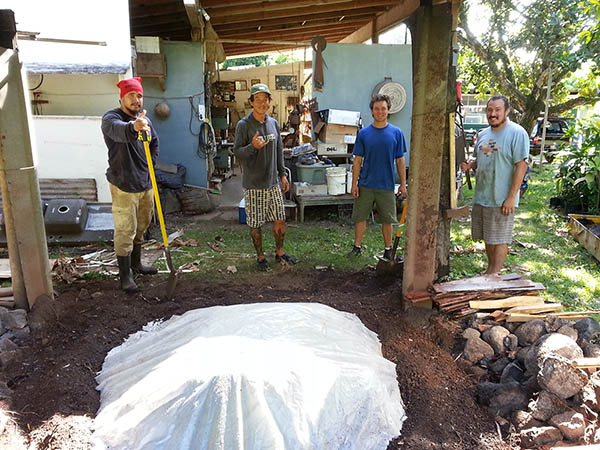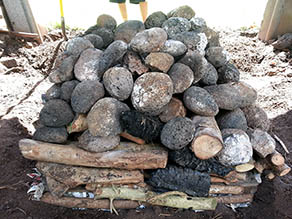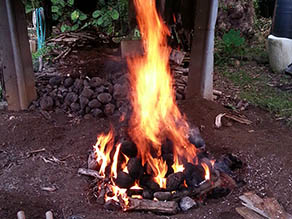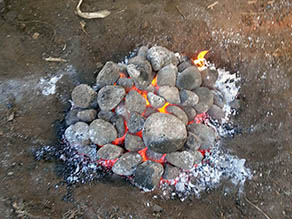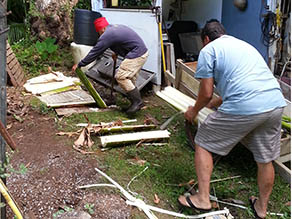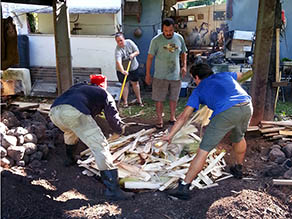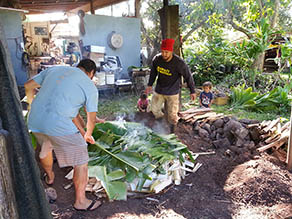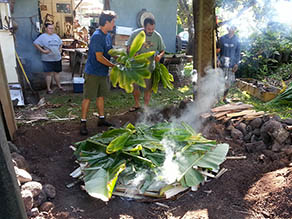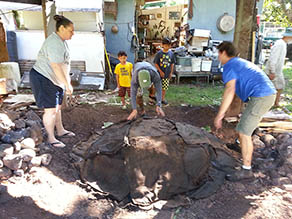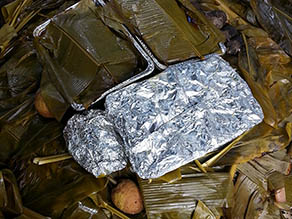 |
 |
 |
|||||
|
Cooking in an Imu:
“Traditionally, only men cooked,” Kanekoa says. “You cut a hole. If it’s a square hole, it usually means for cooking people," he jokes. "Circular holes are usually meant for food. You get clean river rock with a lot of holes so that the gases can build up. You put it on a fire, heat the rocks up, put your plants down—banana stumps. Banana stumps contain a lot of moisture. They also don’t completely engulf in flames immediately. You can put some tī leaf underneath. You can then put your pig on top. If it’s a whole pig, you put rocks around it. You can put your other vegetables and food inside, and you throw tī leaf on top of that to kind of protect it. “And then you throw banana leaves on top of that, and then they do burlap now where they put burlap, but used to be just banana leaf, and then you can just throw dirt on top of that, and then it holds it in like an imu. Depending on the amount of vegetation and how hot the fire was, you let it sit for 6 hours to 12 hours, and then you’re good to go.” “My family does imu periodically,” says Nick Reppun. “We’ll make an imu, make a whole bunch of laulaus and stash them in the freezer. Or a couple of chickens in there, shred them up, same thing: make a big batch, throw them in the freezer.
|
|
|
|
“Basically, you’ve got indention in the ground, maybe about a foot and a half, two feet deep depending on the size. And it can be any size. I’ve seen imu that are three feet across. There’s also one that happens every year around Thanksgiving at Key Project, and that’s a huge imu. I mean, they do about 500 turkeys, so it’s like a fundraiser. That one is probably like 20 by 40 feet. It’s a huge pit, and the turkeys get stacked like three deep all the way across the whole thing, which is pretty awesome. “But anyways, you’ve got your imu pit, the indentation in the ground. The first thing you do is you build up all of your wood, stack all of your wood in there, and then rocks get stacked on top of the wood. The rocks are basalt, that’s what we have here, but people always look for ones that have pores in them. They’ve got little holes and air pockets in them. I think they absorb heat easier that way, as opposed to being completely solid. “Usually, people are collecting the rocks out of a river or a stream mouth or something like that. The rocks broke off of the mountain however long ago, and they rolled all the way down to where we collect them out. You could use angular ones but I think that’s just what people can get.” “You got your wood piled up, put your rocks on top, and then you light the fire. You light the wood that burns and heats up the rocks. If you’ve got really big chunks of wood, sometimes you have to take then out. They don’t burn fully, and so after your rocks are hot, you’ve still got big chunks of wood. You take some of those out so that they don’t continue burning, because you want your primary heat source to be the stones themselves and not combustible material.
|
|
|
|
|
|
“You usually have to level out the stones a little bit once they are hot, spread them out in the pit a little. And then you cover the stones with shredded banana stumps. People call that hali‘i. They take a banana trunk, cut it into sections with a machete and shred it up—pound it with a hammer or an o‘o or something. You get a good layer of those down over your stones. And that does two things. It creates a heat buffer between the stones themselves and whatever food you’re going to cook. And then also the banana trunk has a lot of water built into it in the cells. And so it creates steam too, so you’re kind of like steam-cooking things.
|
|
|
|
|
|
“So your shredded stumps go over the rocks. Banana leaf covers that, and that’s probably so you don’t get the sap from the stumps into your food necessarily. And then you put your food down. Some people put tī leaf too, but then you’re putting your food down on top of that. Some people put a whole pig in there, but whatever you’re going to cook goes inside.
|
|
|
|
|
|
“You usually put tī leaf over the food and then banana leaf over that. In the olden days, they would’ve covered that with dirt. Some people still do that now. Nowadays, a lot of people will put down a layer of burlap sacks over the leaves, and then a piece of tarp, like a big sheet of plastic or something to kind of seal it in, and then you put dirt around the edge of that to seal it; hose down the dirt a little bit, so it just kind of weighs it down and provides a seal. “And then depending on how much food you got in there and how big it is, it’s probably three to five, six hours of cooking and then open it all up, take your food out, have a big party, whatever you do.” |
|
|||||
|
|||||
